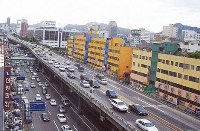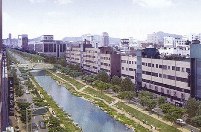
< World's WATERFRONT:WORLD Category: Restoration Project >
Mersey River was polluted as the industrial revolution proceeded, and for two hundred years, it had been deemed as the most polluted river in Europe. Its water environment started to improve in 1960s. The financial and environmental restoration activities were started for the Mersey River basin that had the problems of declining economy, devastated cities, and environmental issues.
From 1980, as a project to clean up the river mouth, a 15-year investment plan (170 million pounds or 34 billion yen) for cleaning the sewage wastewater was started by the government. From 1985, this effort was continued as Mersey River Basin Campaign, run mainly by the environment ministry. It is a 25-year program with the total budget of four billion pounds invested by the government and companies. It is a “world-encouraging advanced example” and is highly evaluated in EU as well as in UK.
>>More details (PDF 36KB)
By JRRN-secre | Category: Restoration Project,Europe | Comment(0) | Trackback(0) |
Date: 2008.03.31 19:21
Waza-Logone Floodplain ranges over 8000 km2. It has the people with various businesses who base their lives there, and has rich biodiversity. However, after a dam to support the local economy and living was constructed, the natural functions of the floodplain were lost. The social and economic impacts of the lost floodplain were serious, loosing over 50 million dollars of basis for human life in the twenty years after the dam construction.
Approximately 8000 households suffered from the direct economic damages of over two million dollars a year, caused by the decreased dry-season grazing, fishing, yields of natural resource, and surface water supply. The suffered were mostly stock farmers, fishers, and dry-land farmers who represented the poorest and the weakest group in the region.
>>More details (PDF 32KB)
By JRRN-secre | Category: Restoration Project,Africa | Comment(0) | Trackback(0) |
Date: 2008.03.31 19:21
Evergrades in Florida had a wetland called “river of grass,” formed by water flowing in the dimension of 2.9 million acres (11700 km2) from Okeechobee Lake.
Kissimmee River had experienced water quality deterioration and aridification, caused by farmland reclamation and flood prevention. After the flood in 1947, river improvement construction was conducted to straighten the river course, which changed the shape of the river. Now Evergrades is proceeding a world biggest project for wetland conservation and restoration with the total cost of 7.8 billion dollars. Kissimmee River’s once straightened river course has been re-winded in order to recover the wetland.
>>More details (PDF 33KB)
By JRRN-secre | Category: Restoration Project,North America | Comment(0) | Trackback(0) |
Date: 2008.03.31 19:19
Shanghai is a big city with the population of 16 million (including 3 million guest laborers). Forests of tall buildings are observed along the opposite bank of PuDong’s economic deregulation area.
Shanghai, estimated by the World Bank, will grow into a city of 25-million population by 2010. It is among the big cities developing at the “Arian speed” and the “Chinese scale.” Therefore the problems that accompany urbanization is quite noticeable.
>>More details (PDF 40KB)
By JRRN-secre | Category: Restoration Project,China | Comment(0) | Trackback(0) |
Date: 2008.03.31 19:18
Most rivers in southwestern region (SWR) of Bangladesh depend on water flow from Ganges River. The flow volume declines during the dry-season and it impacts the region. Many of the branch rivers of Ganges River are blocked off from Ganges River due to the water intake at the upstream Indian Farakka Barrage that was built in 1975. Gorai River, a branch of Ganges River, is one of the major sources of freshwater supply to SWR and is the only one remaining branch river. However, in at least these twenty years, its flow volume in the dry-season (December – April) has been declining. It has a serious environmental impact: especially along the coastal areas around the sanctuary forests where the salty water has increasingly been intruding. In December 1996, the Bangladesh government decided to implement “Gorai River Restoration Project (GRRP)” to meet the urgent need of dredging Gorai River to restore the dry-season’s flow volume in SWR and the regional ecological balance. The research has been in progress through EGIS (Environment and GIS, Dhaka) for the problem of the Gorai River’s declining flow volume, and various alternatives and technological solutions have been studied (by the School of Geography, University of Leeds, UK). The Gorai River’s inflow point used to be closed in the dry-season, but thanks to the dredging with the PPW (Pilot Priority Work) Program, through the investments by the Dutch and Belgian governments, it has come to be kept in an open condition.
>>More details (PDF 35KB)
By JRRN-secre | Category: Restoration Project,Other Asina Countries | Comment(0) | Trackback(0) |
Date: 2008.03.31 19:18
The primary elements to decide the ecological environment of a large river and the neighboring floodplains are the scope, the period, and the dynamics of hydrologic connection between the river and the floodplains via the surface layer current and the groundwater. That hydrologic connection has been badly lost in all the large rivers in Europe, due to water channel improvement constructions and to dam constructions. For Danube River which flows along the jurisdiction of Austrian “alluvium area national park,” as the first step of restoration strategy for freely-flowing river, a large-scaled pilot project has been in progress to restore the hydrologic and ecological completeness of the system between the river and its floodplains.
>>More details (PDF 38KB)
By JRRN-secre | Category: Restoration Project,Europe | Comment(0) | Trackback(0) |
Date: 2008.03.31 19:17
As industries were developed and population increased, the inflow burden on Chesapeake Bay was increased. As a result, the bay, which was closed, became gradually polluted. Aiming at regaining rich natural environment, the federal government and the state government, with cooperation by near-shore waters concerned parties, established “Chesapeake re-program” in 1987. Many of the concerned parties participated in this program, including the federal government’s Environmental Protection Agency (EPA), National Oceanic and Atmospheric Administration (NOAA), the universities and research institutes in the relevant four states, and NGOs. This program focused on restoring fish and marine life in the bay, and its activities included: prohibiting phosphorous detergents, improving agricultural management, organic removal of nutrient salts, the sewage system and wastewater regulations, and the
penetration of environment education among people. Mitigation works were conveyed, and wetland restoration and seaweed bed creation were also started. After an agreement in 2000, this program has much progressed and has contributed to conserving and recovering the environment in the bay.
>>More details (PDF 32KB)
By JRRN-secre | Category: Restoration Project,North America | Comment(0) | Trackback(0) |
Date: 2008.03.31 19:16
Cheonggye River used to flow between Chongro and Uruchiro, but it became an underdrain after being covered by a road, and by another elevated road. But after thirty years after construction in 1968, Cheonggye elevated road became old. In recent years measures such as reenforcement and heavy vehicle restriction were taken, but the road became dangerous for use. In 2002, Yi Myongpac, who committed to solving the problems, removing the road, and restoring the river, won the election of the mayor. Given that, Cheonggye River restoration project was rapidly put into shape. This is the world’s first case of urban re-development project removing the road and restoring the river, and collects people’s interest worldwide.
>>More details (PDF 44KB)
By JRRN-secre | Category: Restoration Project,Korea | Comment(0) | Trackback(0) |
Date: 2008.03.31 19:14
Boston Bay restoration project is one of the largest in scale in the States involving 43 cities, 2 million people, 5500 enterprises, 11-year construction, and 3.8 billion dollars of cost. The United States Massachusetts water resource bureau, established in 1997, not only adjusted the 43 cities’ interests but led a project hiring a number of expert staff, and gained a great number of citizens’ cooperation to secure the financial sources required for the project (public involvement).
Boston Bay restoration project has substantially improved the water environment in the bay. It has given the local people the sense of confidence and pride, and is said to have contributed to activating the local economy.
>>More details (PDF 54KB)
By JRRN-secre | Category: Restoration Project,North America | Comment(0) | Trackback(0) |
Date: 2008.03.31 19:11
<< Previous |







